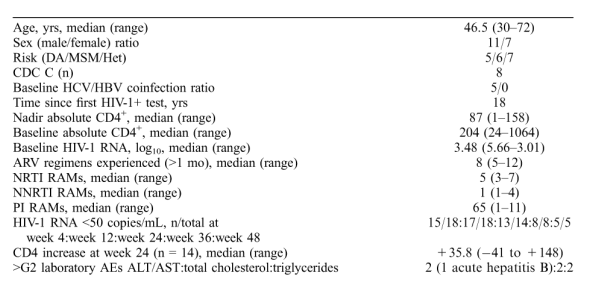| |
Is Dual Therapy With Raltegravir and Protease Inhibitors a Feasible Option in Rescue Strategy in HIV-1 Infection?
[Letters to the Editor]
|
| |
| |
JAIDS Journal of Acquired Immune Deficiency Syndromes:Volume 50(2)February 2009pp 233-234
Capetti, Amedeo Ferdinando MD*; Piconi, Stefania MD*; Landonio, Simona MD*; Rizzardini, Giuliano MD*; Perno, Carlo Federico MD, PhD
*1st Division of Infectious Diseases Luigi Sacco Hospital Milan, Italy
Department of Experimental Medicine and Biochemical Sciences University of Rome Tor Vergata Rome, Italy
No financial support was given for the study.
To the Editor:
Since the advent of highly active antiretroviral therapy, the rule of 3-drug combinations has become a well-recognized need in the treatment of HIV-1 infection. Two-drug combinations always proved to be less effective,1,2 and 4 drugs have been so far found to be no better than 3.3 However, in the salvage setting, the concepts of active drugs and genotypic sensitivity score flanked and often substituted this simple rule.4 Although rescue drugs generally seem to be effective in the presence of a genotypic sensitivity score (GSS) ≥ 2 in the optimized background regimen (OBR),5 in the Benchmrk trials, the integrase inhibitor raltegravir has shown to suppress HIV RNA to <50 copies per milliliter in 67% of the subgroup of patients having a GSS = 1 in their OBR at a follow-up of 24 weeks.6
In our cohort of patients treated with raltegravir as part of a rescue regimen, in the Merck 023 Expanded Access Program, 18 of 44 patients had the only choice of a boosted protease inhibitor available to build an OBR. Nine patients had experienced virologic failure with enfuvirtide, 5 had discontinued it due to injection site reactions, and 4 refused to assume it. Maraviroc and etravirine were not available at that time in our center. Nucleoside reverse transcriptase inhibitor and nonnucleoside reverse transcriptase inhibitor GSS was in all cases = 0. On this basis, the physician's decision was not to include inactive drugs, so dual-therapy regimens were designed, in which raltegravir was associated with boosted darunavir (n = 13), boosted lopinavir (n = 1), boosted atazanavir (n = 3), and unboosted atazanavir in a patient absolutely intolerant to ritonavir. While presenting numerous mutations in the protease, the virus enzyme of all patients was fully sensitive to the chosen protease inhibitors according to both the Stanford and TruGene algorithms (GSS ≥ 2). Five patients switched to the dual darunavir + raltegravir regimen presented 1 relevant protease mutation7 (three 84V, one 54M, and one 73S). The cohort's characteristics are summarized in Table 1.
Two of 18 patients were absolutely nonadherent to the regimen and persisted in exposure to their risk factor (men who have sex with men). One of them developed acute hepatitis B, discontinued his antiretroviral therapy, and did not return to the clinic to restart it after recovery. The other patient relapsed into serious depression and dropped all drugs refusing to be cured. Of the remaining 16 patients, 15 rapidly reached <50 copies HIV-1 RNA per milliliter by week 4, and the remaining patient achieved this result at week 8: all had viral load still <50 copies per milliliter by week 12. None of them interrupted the study up to date. Therefore, all adherent patients had undetectable viral load at week 12 (16/16) as all patients who have already reached week 24 (10/10). The mean immunologic gain of the 10 patients who reached week 24 is +51.8 ± 53.6 CD4+ T cells per cubic millimeter. Of interest, 3 patients switching from enfuvirtide showed a slight reduction in CD4 count (-22, -41, and, -18 cells per cubic millimeter) after starting raltegravir + boosted darunavir. No grade 3 or 4 adverse events or laboratory abnormalities were reported with the exception of the patient who developed acute hepatitis B. One patient showed a 2-fold increase in alanine aminotransferase and aspartate aminotransferase by week 12, not confirmed at week 24, and 2 patients showed a G2 increase in total cholesterol and tryglicerides by week 12. Both started from a G2 level and were successfully treated with rosuvastatin.
In conclusion, in our cohort where the treatment choice was so narrow, this regimen proved to be potent and highly effective (at least at this short follow-up evaluation), simple, and well accepted by patients. Taken together, these observations confirm, as a proof of concept, that the great potency of raltegravir, combined with the potency and high genetic barrier of darunavir, may represent a valuable option in selected patients without chances of building an effective 3-drug regimen. Data on long-term follow-up is though warranted to confirm and extend these results.
TABLE 1. Characteristics of the Dual Raltegravir/protease Inhibitor Regimen Cohort (n = 18, Median Follow-Up Since Starting Raltegravir 32 Weeks, Range 12-60 Weeks, 14/18 ≥ 24 Weeks)

|
|
| |
| |
|
|
|